PADI on rebreathers: Are they safe for recreational divers? PT2
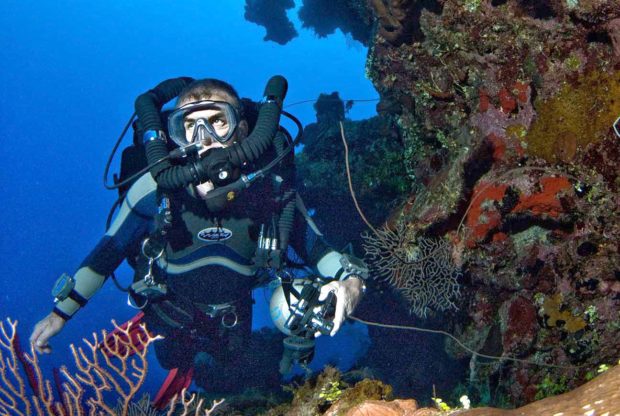
The Professional Association of Diving Instructors (PADI), the world’s largest scuba training agency, has expanded its course offerings in recent months to include recreational rebreather instruction. What follows is the continuation of an interview with Mark Caney, PADI’s Vice President of Rebreather Technologies, published in the current issue of DIVER Magazine, available by subscription on this site or at select newsdealers.
Interview by Michael Menduno
Are rebreathers safe for recreational divers? The world’s largest dive training agency thinks they are, and they’ve developed courses for the rec and tec diver alike. Here, the agency’s Vice President of Rebreather Technologies, Mark Caney, weighs in on PADI’s new direction, the rise of a new ‘Type-R’ recreational rebreather, and the voice of opposition.
DIVER: Some critics accuse PADI of promoting this technology to divers who have no business diving a rebreather, simply in order to boost revenues. What would you say to them?
Mark Caney: It’s not something we want to force people into. It’s not that we’re saying here’s a great way to make a load of money. Our members have been asking for a rebreather course for a long time and we have held off. We didn’t rush in and think, “Oh great we can make all this money from rebreathers.” Not at all. We wanted to be sensible about this and get involved only when we felt the technology and the marketplace was mature enough to support this in a reasonable way. And we believe that time is now.
I get that.
Mark Caney: Make no mistake about it; although we’re talking about a recreational Type R machine, it’s more complex and requires more discipline than simple open circuit does. And so there are additional risks, no question, and there need to be additional protocols for handling those risks. It is more advanced than existing open circuit scuba but we think it’s reasonable and our members want it.
So yeah, we felt the time was right to get involved, and if we can influence the development of this in a way that is safe and is going to benefit divers, then good. I don’t think rebreathers are going to go away. Recreational rebreather divers exist and there are more people that want to become recreational rebreather divers. We just can’t put our head in the sand and pretend they’re not there.
DIVER: So the benefits of rebreather diving are appealing. Recreational divers can double or better their no-stop bottom time, dive in silence in the absence of bubbles, and be able to get up close and personal with the wildlife. On the other hand you have to acknowledge that the risk is very sobering. Australian hyperbaric physician Dr. Andrew Fock, who is a very accomplished rebreather diver and gave a riveting presentation at Oztek last year in which he estimated that the risk of dying on a rebreather could be as high as 10 times that of open circuit scuba, based on fatalities from all the available data bases such as DAN, BSAC etc. Does that give you pause?
Mark Caney: Any time there is a potential for an accident it does give me pause. And certainly rebreathers do give divers a variety of new ways to kill themselves. And it’s a risk that needs to be appreciated by the diver and then managed to a reasonable degree. Of course, what’s ‘reasonable’ can vary from one person to the next!
But with regards to the data, I would say, yes, there is an increased risk with rebreather diving at this point in time. That’s the experience you see in the marketplace. Per capita there seems to be a higher level of accidents with rebreathers than with open circuit.
However, there is something to temper this. A lot more of the extreme, exploratory dives are being done on rebreathers these days, and that’s where the accidents do frequently happen. If those same divers had been on open circuit they probably would have had a lot of accidents as well. So that’s one aspect of this situation. The other is that if you look at the history, on a lot of the rebreather dives where people had fatal accidents, they were really working outside the established parameters. They were diving solo, or very deep and not following a lot of the basic protocols, like having sufficient bailout gas.
DIVER: Fock presented a probabilistic analysis that rebreathers were roughly 20 times more likely to fail than an open circuit set of double tanks, so carrying sufficient bailout is essential.
Mark Caney: I think that’s the old story you hear frequently with diving. If you follow all the rules, it’s very unlikely that you’ll have an accident.
The complexity with rebreathers is that you tend to get more rules. So there are more things that the diver has to follow. Of course, this can be countered with good training and, as much as possible, the manufacturers need to engineer out as many problems as reasonably can be done, because there are limitations on the human side of the equation. I mean we all have bad days. I have jumped in the water with my dry suit unzipped. You have probably done things you wished you hadn’t as well. Everyone has. So mistakes do happen. But they can be minimized with the use of checklists and diving with a buddy, etc. The more you can reduce the odds of making a mistake, the safer you are.
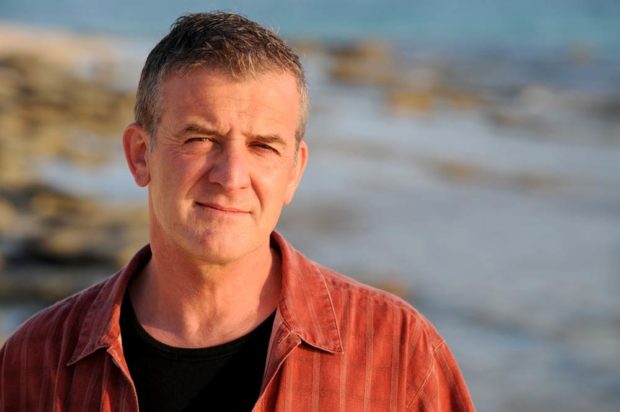
DIVER: You don’t want to die because you had a bad day!
Mark Caney: That’s right. And of course that’s why we have so many backups in technical diving, so we can minimize the impact of those bad days.
DIVER: My understanding is that the accident data for rebreathers is not at all black and white. Presumably diving extreme exposures add to the risk factor, and so does solo diving, but there have been numerous deaths of experienced people in shallow water as well. I’m thinking of veteran explorer and cinematographer Wes Skiles who died on a rebreather in 2010 during a film shoot on a reef in around 65 feet (20m). You could argue that Wes, who had logged thousands and thousands of dives, would never have died on open circuit on a dive like that.
But your core premise is that the risk of diving a rebreather is greatly reduced if:
a) divers are using a Type R machine that is relatively fool-proof and will alert them to any problems
b) divers stay within the recreational no-stop 130 feet (40m) envelope
c) divers go to open circuit and terminate the dive if anything goes wrong, assuming they know something has gone wrong.
Do I have that right?
Mark Caney: Yes. We believe that the recreational diver concept will work if certain parameters are in place. One is that you’ve got a machine that is relatively forgiving of diver mistakes. The second part is, you have a very limited environment. You’re talking the traditional recreational envelope. We’re down to usually 100 feet (30m), no decompression, and open water above. And that means your training requirements can be reduced.
You don’t need the diver to know lots of complex protocols to deal with emergencies. Because if something goes wrong, the machine will warn the diver that something is wrong, and he or she has more or less only one solution to the problem: go to bailout and ascend. I repeat; if you have a serious problem, you terminate the dive.
Now technical diving is a whole different ball game because the diver may have to do an extended period of decompression before surfacing, and he or she may have to swim out of an overhead environment. So the tech diver needs a complex set of management techniques to overcome problems he or she may encounter. Frankly, I think that’s where most of the criticism of PADI offering recreational rebreather classes comes from. People are looking at what it takes to use a rebreather in a technical diving setting and are saying that you can’t teach that to recreational divers. No, of course you can’t, but they’re not going into the environment where they need that skill set.
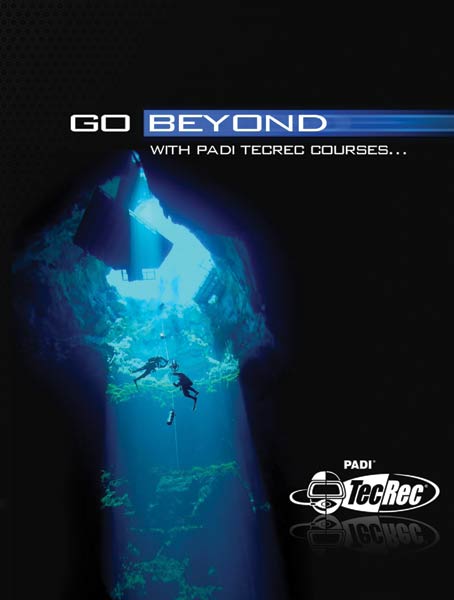
DIVER: That’s a good point. PADI’s approach is based on a much more limited use case. How much additional risk do you think that recreational divers will incur diving a rebreather vs. open circuit scuba?
Mark Caney: There’s probably no hard number to put on that. There is additional risk because there are more potential things that could go wrong. But then you’ve got more potential solutions too. So as long as it’s managed properly the additional risk could be fairly incremental. Of course the sophistication and the reliability of the machines will play a role here. So you can theoretically remove a great many potential hazards through good engineering. Of course this puts the burden on manufacturers.
DIVER: So the jury is still out?
Mark Caney: I really believe that some good design and good engineering can eliminate a lot of the predictable problems that you could expect a recreational user to make. But yes, just now this is a theory, and implementation is at issue as well. There’s a difference between being able to theoretically engineer something, and doing it reliably and consistently over time. We will only be able to find out if it worked when we see how successful manufacturers have been over a long period of time.
DIVER: That begs the question, is this all a kind of grand experiment on recreational divers?
Mark Caney: Oh, no. I think we are at a good enough point that we can start to apply this thinking now, but I am sure it will improve. Nothing stays still. So something like the Poseidon MKVI or the new Explorer machine that Hollis plans to launch are examples of new approaches that meet the need now. But no doubt in five to 10 years, we’ll see improvements and the manufacturers will get more refined and better at doing it.
DIVER: You said, a little earlier, “Because if something goes wrong, the machine will warn the diver that something is wrong.” It seems to me that this is a big assumption. I understand in some cases divers don’t realize they have a problem until it’s too late. For example, that their oxygen is too low or two high. And at that point they pass out or go into convulsions and drown. Not to mention CO2 problems.
Mark Caney: And that’s why I think the kind of rebreathers we’re going to be seeing coming out in the next year or two will have a high degree of awareness in the machine itself. In other words, they will monitor a lot of things that can go wrong and will either fix them or warn the diver when that happens. Having a reliable detection system and sufficient warning to act when something does go wrong will improve the safety significantly.
DIVER: Interestingly, I had a long talk with Dr. Richard Pyle, arguably one of the most experienced rebreather divers on the planet, who designed much of the MKVI with Stone. He said that their goal in building a machine that was appropriate for recreational divers was that the machine had to basically think better than a “well-trained” diver. When I spoke with James Roberton, at Poseidon, he said the same thing this way. “Who would you rather have planning and monitoring your dive, yourself (a recreational diver with 25 dives under your belt) or Dr. Bill Stone?”
Mark Caney: I don’t think it necessarily has to think better than the diver, but it has to think as well as a good diver, if he or she is not at their best. All divers have bad days. There’s no reason why a computer needs to have a bad day.
DIVER: Pyle said that when they were originally approached by Poseidon in 2005, and given the challenge of building a machine that could be safely used by recreational divers and wouldn’t cost too much, they spent quality time thinking about all the ways that people die on rebreathers. They concluded the most critical thing is to know exactly what the diver is breathing at any point in time, especially with respect to oxygen levels.
With open circuit of course, you always know what you are breathing and what your O2 levels are, but in a rebreather the breathing mix is dynamic. People seem to agree, generally, that galvanic O2 sensors at the core of a closed circuit rebreather are at once the critical, and also the weakest link, in the system.
Mark Caney: Yes, knowing the oxygen levels is critical because the oxygen can cause you problems in either direction.
DIVER: Pyle said this led them to developing their ‘Active Sensor Validation’ technology; the software automatically validates the response of a pair of O2 sensors in one and five minute increments so that the electronics can determine whether or not the sensors are accurate. That’s what he meant by “thinking better than a well-trained diver.”
He said, that they were close to perfecting the technology, which he believes is superior to the three ‘voting’ sensors system used by virtually all other rebreathers today. (In this system the sensors vote. If two or more of the 3 sensors agree, PO2 levels for those sensors are judged accurate). He considers it a quantum leap improvement in rebreather safety, and that it could potentially issue in a completely new paradigm for rebreathers – that is, the ‘recreational rebreather.’
Mark Caney: I also think that C02 is probably more of a hazard than was traditionally thought and I think people are becoming more aware of that.
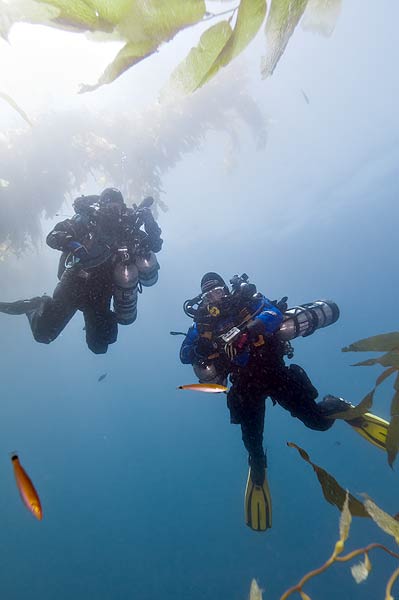
DIVER: Yes, Pyle added that he thinks that tech pioneer Kevin Gurr, CEO of VR Technology Ltd. – another big brain! – has solved the CO2 sensor problem. And so, maybe for the first time, you’d have a closed circuit rebreather that could display the dynamic breathing mix with near certainty at all times.
Mark Caney: Absolutely. I think that’s what we’ll see. In 10 years time, we’ll probably have rebreathers where both of those two gases are very much under control, and the diver will get a warning if those things are starting to get out of line.
DIVER: Of course, this begs the question, what about divers who don’t have one of these machines? I mean some machines may do a better job of keeping divers safe than others.
Mark Caney: Most of the machines on the market will give you a reasonable idea of what is happening with the oxygen levels and Kevin’s CO2 detection system does seem to work. And there is promising technology on the way. I do think that CO2 detection will become commonplace in the near future and will become fairly sophisticated so that the diver will get some warning when there’s an issue of CO2 buildup for whatever reason. Of course, in the absence of reliable CO2 detection built into the machine, you’ve just got to be disciplined and rigid about using CO2 build-up prevention methods.
DIVER: Of course I put the question to Pyle, on his scientific honour, if he actually thought if it was possible to build a rebreather that could be safely used by recreational divers. He said that when they started on this project, his answer would have been no. But now after spending years working on the problem, he said his confidence has increased to the point where he now believes it is possible. He said he was 90 per cent there. That’s a strong statement from a scientist! Of course, you might not want to hire him as your marketing guy!
[Caney chuckles].
DIVER: So PADI launched its recreational rebreather diver courses last September and you’ll be rolling out your Tec rebreather courses this spring. Is that right?
Mark Caney: Yes, there are two levels of recreational courses, the PADI Rebreather Diver course and the PADI Advanced Rebreather Diver course, and they are both out. The Rebreather diver course includes a total of six dives and takes the diver to 65 feet (20m) with air or nitrox diluent. The Advanced course includes five dives and allows a diver to go to a maximum depth of 100 feet (30m), but if the diver has Deep Diver certification, they can go as deep as 130 feet (40m). The primary difference between them concerns bailout requirements. Down to 60 feet (18m), the diver can usually use the onboard bailout. For dives deeper than that they need additional bailout gas. The Tec CCR (closed circuit rebreather) courses more closely follow PADI’s open circuit Tec program.
DIVER: I know that PADI emphasizes the risks of tech diving in its training materials in stronger language than in its open water courses, and you’ve also acknowledged that recreational rebreather diving involves additional risk. My question is whether you beef up the warnings in your rebreather courses? Do you tell people they can die on these machines?
Mark Caney: If people are doing an activity where there are risks, you have to spell it out to them exactly what those risks are. So, we don’t mince our words on this. We make it clear where the dangers are. If you don’t follow the rules, you’ll get into problems.
DIVER: I would be remiss if I didn’t poke a little fun here. Isn’t naming your recreational course ‘Advanced Rebreather Diver’ a little misleading in that it gives students who complete the course, shall we say, an inflated sense of their own capabilities? I mean the same issue applies to your ‘Advanced Open Water Diver’ certification.
Mark Caney: That’s exactly why we did it. There are literally millions of Open Water Divers and Advanced Open Water divers out there. The industry knows what that means. People understand the capabilities of those two certifications. And recreational rebreather divers are basically the same animal with different gear. So they know what exactly their intended envelope is.
DIVER: Ha! I hadn’t thought of that. Why change horses mid-stream!
I understand that an instructor needs to have 75 hours on a rebreather and at least 50 hours on the specific machine that he or she is going to teach as a PADI recreational rebreather instructor. Is that a reasonable amount of experience for a rebreather instructor?
Mark Caney: If you’re talking about time in the water, you have to have at least 100 dives on open circuit to be an instructor and that’s before you commence logging hours as a rebreather instructor. So the overall time in the water is quite significant.
So I think 75 hours is reasonable when you’re talking about recreational instruction. But I acknowledge that is a criticism that’s going to be easily raised by people. But consider this: we are not talking about technical diving on a rebreather, which requires complex, technical skills. The skills you’re required to learn in a rebreather recreational course represent a much smaller task load. So it makes good sense that you wouldn’t need as many hours logged for a recreational diver as you would for a technical. With 50 hours on a specific machine, an instructor will likely see most of the situations that could arise with the unit and so they’re pretty well prepared for an instructor course. Bear in mind, they need 75 hours of rebreather diving in total anyway. For the technical rebreather programs, we require a lot more experience.
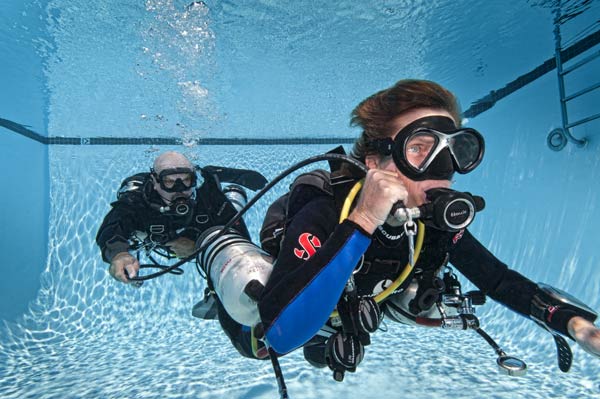
DIVER: How many rebreather instructors does PADI have right now worldwide?
Mark Caney: I actually don’t know. We’ve only had the program out there for a couple of months and haven’t done that many instructor crossover events. So I’ll say there are probably under a 100 instructors at this point. If you ask me in three months time, I think it will be quite different.
What we’ve done is train up a small cadre of extremely experienced rebreather instructor trainers and got them together and spent some time making sure they understand exactly the techniques we’re looking to have in place and also the philosophy that we want to convey. We wanted to make sure the first wave of trainers got it only one step removed from the designers. We’ve tried to keep the message as intact as we could. Inevitably, the initial tranche of instructors are people with existing rebreather instructor credentials that we have crossed over. But we’re not doing any paperwork crossovers. In every case, we’re having people attend a program where there’s a classroom and wet component.
But, we have a lot of PADI instructors in the wings who have been waiting for this and building up their hours so that they can become first time rebreather instructors. They’ve already got the requisite experience as divers.
DIVER: I have heard estimates that as many as 10-15,000 (technical) rebreathers have been sold worldwide since about 1995/1996. By comparison, my understanding is that that Poseidon has already sold more than 1,000 of its MKVI Discovery recreational units. Do you have any projections on how fast recreational rebreather diving is likely to grow?
Mark Caney: It’s very hard to predict that, in part because before we launched our program we had no rebreather instructors, and no history to be able to extrapolate. Having said that, logically we don’t expect huge numbers at first. I’d be surprised if there’s more than about a thousand certifications this first year. But I would expect it to grow fairly exponentially, particularly as more Type R machines come on to the market.
DIVER: What will the future look like?
Mark Caney: I don’t think there’s going to be a sudden dramatic change. But I do think there will be a definite irreversible change. We are going to see a larger and larger segment of recreational divers adopt rebreathers. And it’s hard to guess how far it will go. Certainly it will come down, in part, to how easy and affordable the technology becomes. Just like computers.
And likewise, what we are seeing development wise is probably a good indication of what is to come in the future. And so I think we can expect that rebreathers are going to become more convenient to use by a factor of ten. And once the manufacturers are in a position to sell a lot of these things the relative price will come down too.
• Writer and technologist Michael Menduno published and edited aquaCorps: The Journal for Technical Diving (1990-1996), which helped usher tech diving into the mainstream of sport diving. He coined the term “technical diving.” He also organized the first Tek, EuroTek and AsiaTek conferences, and Rebreather Forums 1.0 and 2.0. Menduno is based in Berkeley, California, and remains an avid diver.
Part One of this interview is in the current issue of DIVER Magazine and will be available here on May 18th.
3 Responses to “PADI on rebreathers: Are they safe for recreational divers? PT2”
Leave a Comment








John Broadwater
This is an excellent–and timely–article! DIVER asked all the tough questions, and Mark Caney responded with strong arguments to support PADI’s new rebreather training course. I have been a technical diver for years, but have cautioned my colleagues against getting into rebreathers (for all the reasons discussed in this interview). However, I agree with PADI that the time has arrived. After all, the use of rebreathers is on the rise, so at least divers now have somewhere to go to get proper training. As a PADI instructor, I support this new course, but still advise caution. Let’s make sure our instructors are well trained and experienced and that the qualifications for acceptance into the course remain high.
JeremyK
I didn’t have time to read the entire article – but well written and in the style of DIVER Magazine which cuts to the chase with great information (as opposed to all of the other crap magazines out there which only serve to sell things).
I do think Mark dodged the question when asked about extra revenue for PADI. He didn’t even mention that it will make PADI more money… which it will of course! Rebreather courses will be more expensive than open circuit and this means a whole new suite of ancillary courses for PADI. I highly doubt the motivation behind adding rebreathers to the mix is solely motivated by the demand of their clients. What percentage of recreational divers even know what a rebreather is? Considering that most rec divers dive on one vacation a year, I bet VERY FEW. So the motivation behind this is not because of demand. PADI’s marketing machine will be able to create demand and they know it.
All that said about Mark’s dodging the question, I am optimistic that this will bring CCR systems into a new place, increase technology for them, and bring prices down. But again on the flip side, more people will die (because PADI’s marketing machine told them about the dream of no bubbles and extended bottom time).
George Huels
Merely a short comment to Mark that I feel deserves to be read by divers in general.
Rebreathes are essentially military equipment and in many peoples opinion should not be used in recreational diving. It defeats the purpose of the joy of diving as it is “real work” and not recreation. Surely, the professional photographer may use such a device at times, however so rarely. If you look at some of the photographic greats that undertake works for NatGeo for example, they do not use rebreathes but simply open circuit scuba.
I do not think that any association should advocate the use of complex equipment purely for the satisfaction of bragging rights of some.
And on a training note, 50 or even 75 hours on a machine like this, is way too little to teach.
Best regards
George
Lt.Cdr. USN EOD II (Ret)